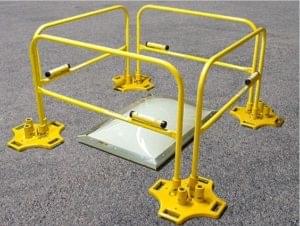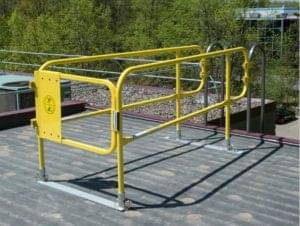Education doesn’t just happen inside of a school building. The roof is a great place to teach kids about solar energy or rooftop gardening. However, with rooftop access comes a need for rooftop safety. In addition to students, maintenance and repair technicians are also likely accessing the roof. Skylights, refrigeration and air conditioning units and general rooftop maintenance can mean frequent rooftop visitors. As a building owner or manager, it is your responsibility to ensure anyone who accesses your roof, can do so in a safe and secure manner. It’s not only a good idea, it’s required by OSHA. Let’s take a look at some of the requirements and how you can get your rooftop fall protection into compliance.
Rooftops are full of potential fall hazards and OSHA requires building owners to provide adequate rooftop fall protection. The perimeter of the roof, rooftop holes like skylights, ladders, and access points all need to have fall protection devices, like a guardrail, in place to keep people from falling. Warning signs are also imperative to alert visitors and maintenance personnel about potential fall risks while on the rooftop.
According to OSHA’s rooftop fall protection guidelines, anyone and everyone who may access your school's roof needs fall protection. Maintenance personnel, contractors, janitors, and even students and teachers may make their way onto the roof. While professionals who spend a great deal of time working on rooftops may have the necessary training to mitigate fall hazards, most people do not. Therefore, it’s necessary to create a safe environment for individuals at all levels of experience.
Perhaps one of the most dangerous places on any rooftop is the leading edge. Whether it's a narrow ledge or a flat surface without any border, it’s always a potentially hazardous location. To mitigate risk, a rigid guardrail or safety railings can be installed around the perimeter of the rooftop. To be in compliance with OSHA guidelines, ensure your guardrails and other rooftop fall protection systems are properly installed and meet all the necessary requirements.
Many times, educational facilities have multiple roof openings that can pose a hazard. Skylights and roof access points are the most common. These areas are not meant to be walked on and keeping people off them is a simple matter of installing a guardrail around the problem spot. These guardrails usually have gates, so gaining access isn’t an issue if there’s a repair that needs to be done.
In most educational facilities, the building's HVAC equipment is located on the rooftop. It’s an ideal location because it's both where there's space and where the equipment works most efficiently. HVAC contractors and maintenance personnel must be able to access these units to prepare them for the school year and perform as-needed repairs. Surrounding the equipment with safety railings keeps unwanted individuals out and allows for safe, easy access for maintenance.

Another area of concern for rooftops is access ladders. Whether they are permanently attached to the building or free-standing, ladders can be extremely dangerous. Fixed ladders must be securely attached to the building so that they do not pull away when someone is ascending or descending. It is vital that ladders are regularly inspected for flaws or weaknesses that would render them dangerous. A guardrail or other protection device may be required at the base and top of the ladder so be sure to check the OSHA regulations for your particular site.
Late summer is the perfect time for roof repairs and necessary maintenance to be carried out. The school is empty of students, teachers, and parents, which makes the job safer and easier. It's also the time of year that the sun is at its hottest. This puts rooftop workers at risk for heat-related illnesses. Protecting workers from the heat as well as any potential fall hazards is a top priority. Adequate cool water, shade, and fall protection devices are imperative to a worker's ongoing safety and well-being.
While it’s ideal to work on the roof when school is out, you’ll still need to access it throughout the year. Weather like wind, ice, and snow make maneuvering on a rooftop that much trickier. Regardless of the season, fall protection should be a critical part of your school’s rooftop maintenance plan.
Inclement weather can wreak havoc on a building's roof. Debris from nearby trees, roofing materials that have become dislodged and damage caused by accumulating water and wind create fall hazards that must be addressed. Removing debris in a timely manner, and repairing damage helps to minimize the hazards. As with repairs and maintenance, fall protection devices must be in place to keep those who are managing the clean-up safe from slipping, falling, or otherwise being injured.
On occasion, students and teachers may access the school's rooftop to perform science experiments or to maintain a rooftop garden area. These are enriching educational experiences and students can learn a lot from them. However, roofs are dangerous places, and the same fall protection devices that keep workers safe will also prevent students from falling. Make sure whatever fall protection you choose is OSHA compliant and installed properly.
The best protection against rooftop falls is keeping people off the roof to begin with. Warning signs letting people know that access is restricted to authorized personnel only will keep most people away. Locking internal roof access doors and removing or blocking ladders and other outside access points are also effective deterrents. It may also be necessary to monitor the building and roof area using video surveillance cameras monitored by security personnel.
A school's roof, like any other building, is there to protect the structure and provide shelter for people who use it. Whenever anyone accesses the roof, they must be fully protected against falling. OSHA standards for fall protection dictates that building owners are responsible for the safety of rooftop workers and anyone who has rooftop access. Staying compliant with OSHA rules means installing a guardrail, or approved safety railings, around both the perimeter and rooftop holes like skylights and access points. These measures protect workers, as well as any students, teachers, and other individuals who gain access to the roof.